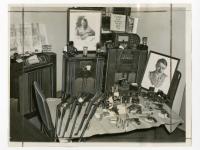The following article was written by HSP volunteer Randi Kamine and is being posted on her behalf. Part two of the article will be posted next Wednesday. Many thanks to Archival Processor Megan Evans for helping prepare these articles for publication.
A slice of Philadelphia history may surprise those of us who live in and love our city. In the late 1930s and the early 1940s, Nazi party affiliates were active in several venues in and around the city. The German-American Bund, in particular, represented those whose sympathies lay with Hitler and Hitler’s Nazi movement. Formed in 1933, the Bund’s membership consisted of American citizens of German descent. Its main goal was to promote a favorable view of Nazi Germany, although documents below show that their mission went beyond propagandizing to enlisting young sympathizers and even preparing for armed conflict. The Historical Society of Pennsylvania archives has photos and documents that trace the appearance and demise of this National Socialist movement throughout the Philadelphia region.
The Philadelphia Record Photograph Morgue (Collection V07) that resides at HSP presents a record of how journalists investigated and covered American Nazi activity from before the Second World War to the American Bund’s demise in the early 1940s. Among the photos are images showing items seized in raids by the FBI in homes purported to be local Nazi headquarters.
One photo, dated October 5, 1942, displays rifles, radios, and photo enlargers, “seized in raids in alien homes” according to contemporaneous notes attached to the photo.
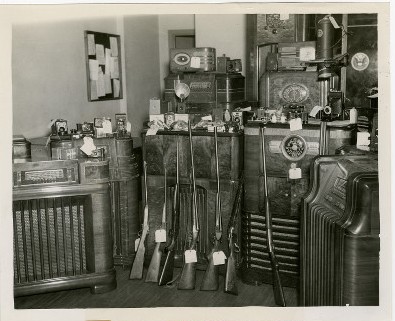
"Seized in alien raids"
In another photo, dated August 13, 1942, Nazi uniforms, guns, and a Nazi flag are shown after they were “seized in yesterday’s raids.”
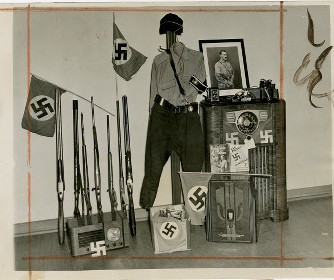
"Item[s] seized by FBI agents early yesterday in a raid on the North Philadelphia home of an enemy (German) alien"
An August 8, 1942 report showing another photo is entitled Symptoms of Fifth Column in Chester. The author writes, “The contraband above, including rifles, revolvers, ammunition, cameras, radios and pictures of Hitler, was seized yesterday by FBI agents in extensive raids on the homes of enemy aliens in Chester and Marcus Hook.” The radios seen in the photos were no doubt used to be in contact with the Transocean News Service which the Commission declared had over 70,000 people on its mailing list. The news service was a wireless German news agency headquartered in Berlin designed by the German Foreign Office and operated by the Propaganda Ministry.
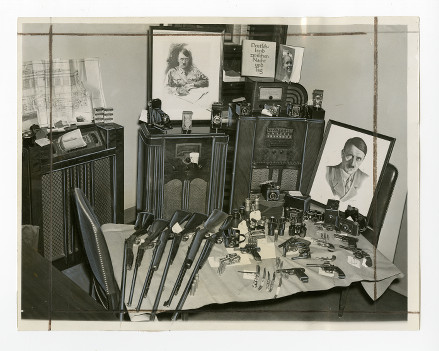
"Seized yesterday [August 7, 1942] by FBI agents"
The photographs in the collection also depict the gatherings and activities of the Bund in and around Philadelphia prior to the war.
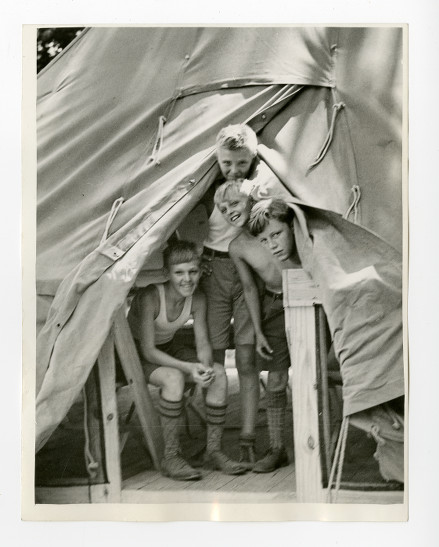
Boys at the Deutschorst Country Club, a recreational gathering place of the Bund, outside of Sellersville, Pennsylvania (July 26, 1937)

Nazi demonstration at Reyburn Plaza, adjacent to City Hall, Philadelphia (1937)
In addition to contemporaneous photographs, HSP has several items that document the tenor of the times, particularly the fear that there existed a “fifth column” ambitiously at work to undermine the United States government. The reports of the famous House Un-American Activities Committee (HUAC) give the reader an insight into this mindset. In the popular imagination the Dies Commission is associated with the rooting out of Communist sympathizers. However, the Committee was originally created in 1938 to uncover citizens with Nazi ties within the United States. HSP has a copy of this initial report. Among its claims, the committee states that the official newspapers of the German-American Bund had advance information on what was about to transpire militarily in Germany. Editions of the paper, Weckruf und Beobachter (Wake-up-call and Observer), appeared in Philadelphia.
A commission report dated January 3, 1941 outlined what the committee perceived as National Socialism’s plans for the United States: “Both Stalin and Hitler have made it plain that their strategy in achieving their objectives in the United States includes the use of Trojan Horses or ‘fifth columns.’ ” The report quotes a statement Hitler made in 1934, “[Nazism] is destined to liberate the American people from their ruling clique and give them back the means of becoming a great nation. … I shall undertake this task simultaneously with the restoration of Germany to her leading position.” The report claims that German-American Bunds had 100,000 members. (This figure is widely believed to be exaggerated. Historians have put membership as low as 25,000. However, mailing lists for newspapers and other propaganda are believed to have been closer to the 100,000 figure.)
Philadelphia figures prominently in the report when discussing the Kyffhauserbund. The Kyffauserbund was a national veterans’ organization in Germany. According to the commission report, a branch affiliated with the German organization was formed in the summer of 1937 in Philadelphia. It appears that its primary function was to promote rifle and pistol practice. From Philadelphia, the Bund spread to New York, New Jersey, Massachusetts, Connecticut, Michigan, and Texas. A leader of the Texas Kyffhauserbund is quoted in the 1941 Commission Report: “We did not need to unlearn anything when Hitler came to power. We were already Nazis when he took the reins of the Reich.”
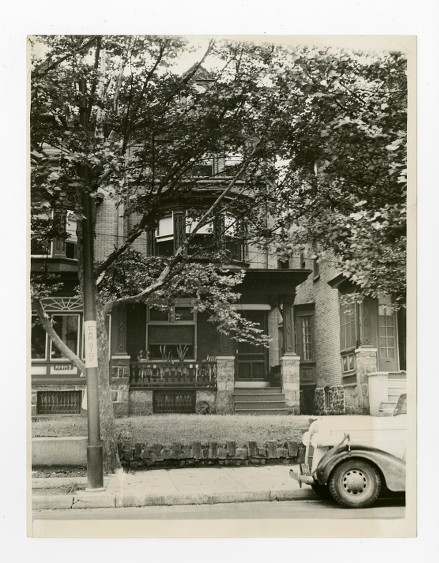
Exterior of a home purported to be the headquarters of the Kyffhauser Bund, 1802 W. Erie Avenue in Philadelphia
The extent to which the United States government was actually in danger is a subject for scholarly debate. It is clear, however, that the Dies reports as early as 1938 saw such a danger and that Philadelphia’s German-American Bund and related organizations were objects of investigation. The reports reflect what was to be written, or had been written, in Philadelphia newspaper reports mentioned above.
Political cartoons from the Philadelphia Record depict the conflict between anti-war groups and those people who had a clear impulse to join in the war on the side of the Allies -- first with financial help, and in the end with military involvement. Among those against the war, it was hard to discern the line between Nazi sympathizers and other anti-war activists.

"Man the Guns, Here Come the Chutists!," cries William Penn, which sport the labels "Lindy" and "Bundists" among other threats to American solidarity
Charles Lindbergh was often an object of scorn in Jerry Doyle’s repertoire of political cartoons written for the Philadelphia Record. Lindbergh gave voice to Nazi fellow travelers and anti-Semites within the America First Committee -- where few members denounced him, and which in 1940-41 called for the United States to stay out of the war. Lindbergh drew overflow crowds, and increased American First chapter membership wherever he spoke. Several of Doyle’s cartoons lambast Charles Lindberg’s anti-war speech given in Philadelphia on May 29 1941. In one cartoon, a smiling Hitler is sitting on a couch holding hands with a fellow Nazi. Joeseph Goebbels is standing by a radio. The words “Lindbergh’s Philadelphia Speech” is coming out the speaker. The cartoon is entitled “An Appreciative Audience.”
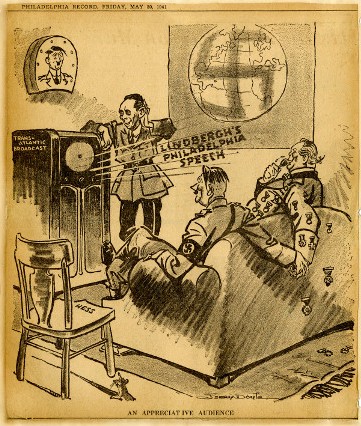
This first segment of two of “Nazi Sympathizers in Philadelphia Before the War,” highlighted photographs and political cartoons that are held at HSP. This is but a sampling. Those interested in Nazism in America, citizen reactions to this movement, and generally, Philadephia before the war, will find a wealth of information in these collections. The second segment will look at some of the Philadelphia Record newspaper clippings that are in our collection.

